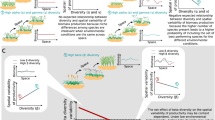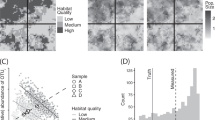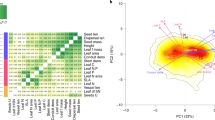Abstract
A wide range of physical and biological systems exhibit complex behaviours characterised by a scale-invariant structure of the fluctuations in their output signals. In the context of plant populations, scaling relationships are typically allometric. In this study, we analysed spatial variation in the size of maize plants (Zea Mays L.) grown in agricultural plots at constant densities and found evidence of scaling in the size fluctuations of plants. The findings indicate that the scaling of the probability distribution of spatial size fluctuation exhibits non-Gaussian behaviour compatible with a Lévy stable process. The scaling relationships were observed for spatial scales spanning three orders of magnitude. These findings should provide additional information for the selection and development of empirically accurate models of pattern formation in plant populations.
Similar content being viewed by others
Introduction
A wide range of physical and biological systems exhibit spatial and temporal scaling behaviour, from the spatial sequences of DNA nucleotides1,2,3,4 to the dynamics of natural populations5. In the context of plant populations, scaling relationships are typically allometric6,7,8,9. Here, we provide evidence of scale invariance in the size fluctuations of plants in even-aged monospecific stands.
Within plant populations, there is often a large degree of variability in the size of individual plants, which reflects differences in age, genetics, environmental heterogeneity and competition. The study of plant monocultures, which are characterised by a comparatively uniform age, environment and genetic background, typically emphasises competitive effects10,11. Nevertheless, size variability also has implications for plant monocultures. For example, size may affect the mortality and fecundity of individual plants as well as the reproductive outcome and survival of suppressed individuals12,13.
Studies investigating size variability in plant monocultures have generally focused on the skewness of size distribution, but other measures of variability, including the Lorenz curve and the Gini coefficient, have been used to investigate plant population structure14,15,16,17,18,19,20. In contrast with previous research, the present study emphasises size fluctuations defined as ZΔk = Sk+Δk − Sk, where Sk is the size (height) of a given plant at the position k in a linear stand and Δk is a spatial scale (an integer).
Results
Data were collected from well-fertilised maize crops (Zea Mays L.) in southern Brazil (23°20′S, 51°57′W; approximately 450 m above sea level) with standard plant population densities: the linear density at a given stand was  4.7 plants m−1 and the typical distance between stands was 0.9 m. Successive measures of the heights of surviving plants were recorded along linear stands [see Fig. 1(a)]. The heights of mature plants were measured from the soil surface to the pennant apex. The data sets correspond to the maize hybrids AG 9010, AS 1570, P 30F87 and P 30K75 and the number of data points are 2203, 2111, 1803 and 2109, respectively. The data for the AS 1570 hybrid are shown in Figures 1(b) and 1(c).
4.7 plants m−1 and the typical distance between stands was 0.9 m. Successive measures of the heights of surviving plants were recorded along linear stands [see Fig. 1(a)]. The heights of mature plants were measured from the soil surface to the pennant apex. The data sets correspond to the maize hybrids AG 9010, AS 1570, P 30F87 and P 30K75 and the number of data points are 2203, 2111, 1803 and 2109, respectively. The data for the AS 1570 hybrid are shown in Figures 1(b) and 1(c).
Definition of size fluctuation.
(a) Typical plants from a crop of maize (Zea Mays L.) grown in southern Brazil. (b) Successive plant size, S (height in centimetres), measured in a linear stand for the AS 1570 hybrid. (c) Successive size increments, Z1 = Sk+1 − Sk, obtained from the series shown in (b).
The probability density function (PDF) of plant size, P(S), exhibited Gaussian behaviour around the peak and a long left tail, which indicates negative skewness [Fig. 2 (a)]. This finding is consistent with previously reported results for maize crops21. In contrast, the PDF of size fluctuation, P(z1), was nearly symmetric, leptokurtic and non-Gaussian [Fig. 2 (b)]. For comparison, we fitted P(z1) to a symmetric Lévy distribution,  , with scale factor γ and index α. As shown in Fig. 2 (b), a good agreement with the Lévy distribution was observed.
, with scale factor γ and index α. As shown in Fig. 2 (b), a good agreement with the Lévy distribution was observed.
Scaling structure of size fluctuations.
(a) Probability density of plant size, P(S), for all records. (b) Probability density of size fluctuation, P(z1), for all records; zΔk = ZΔk/σ, where σ is the standard deviation. Empty symbols are according to the legend in (a). The solid lines are symmetrical Lévy distributions, PL(z), with a scale factor of 0.4 and the following index values: α = 1.68 (AG 9010); α = 1.28 (P 30F87); α = 1.10 (AS 1570); and α = 1.57 (P 30K75). α was obtained by minimum squares fitting. Some curves are vertically shifted for better visualisation. (c) Superposition of P(zΔk) at distinct spatial scales, Δk, for the AS 1570 hybrid. The solid line is given by the Lévy distribution, PL(z), with a scale factor of 0.4 and an index of 1.23. (d) Index α of PL(z) obtained from fits to P(zΔk) for 1 < Δk < 1000. The average values of α,  , were 1.71 (AG 9010), 1.62 (P 30K75), 1.35 (P 30F87) and 1.23 (AS 1570).
, were 1.71 (AG 9010), 1.62 (P 30K75), 1.35 (P 30F87) and 1.23 (AS 1570).
We also investigated size fluctuations for larger spatial scales. We found that P(zΔk) exhibits a common functional form for spatial scales in the range 1 < Δk < 1000. When the PDFs at different spatial scales were superimposed, all the data collapsed onto the same curve [e.g., Fig. 2 (c)]. We fitted P(zΔk), for different values of Δk, to the symmetric Lévy distribution PL(z). In spite of local fluctuations, the index α stayed approximately constant in the range 1 < Δk < 1000 [Fig. 2 (d)].
Discussion
According to the analysis described above, the scaling of the probability distribution of size differences in maize crops exhibits non-Gaussian behaviour that is compatible with a Lévy stable process. The heavy-tailed character of the distribution of size differences, which is consistent across different spatial scales, indicates that rare but relatively large size differences—compared to Gaussian processes—can occur along the stand. As a result, clusters of small fluctuations are connected by these rare and large fluctuations. The analysis of size differences may therefore provide an alternative method for quantifying size inequality in plant populations.
Our findings suggest that the complexity of crowded plant populations may be characterised by scaling properties of size fluctuations. The underlying mechanisms responsible for this pattern may be better understood by considering examples of heavy-tailed distributions in human dynamics. The burst nature of individual activities has been linked to a decision-making process in which individuals execute tasks based on a perceived priority. These priority-based mechanisms can be used to explain a wide range of collective human activity patterns22,23. Analogously, bursts and heavy tails in plant populations may reflect some fundamental and potentially generic features of individual plants. These collective patterns may be related to individual ecological strategies, such as competition for resources and plant physiology and naturally, the effects of different strategies must be considered in tandem. For example, taller plants more readily access light and therefore possess a competitive advantage at any moment during the growth process. However, height incurs numerous costs including past investment, the maintenance of stems and support structures and disadvantages associated with the transport of water to increased heights24.
Size inequality in plant populations has been previously shown to be related to competition, but the underlying mechanisms are still debated. A favoured hypothesis is size-asymmetric competition: larger individuals obtain a disproportionate resource advantage (for their relative size) over smaller individuals, as in the example of competition for light17,25,26. Another hypothesis is related to variations in local crowding: the ability of individuals to obtain resources is affected by the size, proximity and number of neighbours27,28,29. Other proposed mechanisms consider functional interactions among plants that trigger morphological and physiological changes in response to the proximity of other plants. The role of informational photoreceptors in these responses suggests that light-dependent mechanisms contribute to changes in the size structure of plant populations30,31,32,33.
With the goal of identifying and quantifying the mechanisms responsible for size inequality, several approaches, such as reaction-diffusion models, patchy-environment models and neighbourhood models, have been applied to assess the spatiotemporal behaviour of plant populations34,35. However, the distribution of size fluctuation was not addressed in these studies. Our approach should provide additional information for the selection and development of empirically accurate models of pattern formation in plant populations. A natural extension of the present work would be to investigate the robustness of the results with respect to plant development from germination to maturity. Future studies should also include a parallel analysis in other natural plant populations along with a two-dimensional analysis in crop fields.
References
Peng, C. K. et al. Long-range correlations in nucleotide sequences. Nature 356, 168–170 (1992).
Voss, R. F. Evolution of long-range fractal correlations and 1/f noise in DNA-base sequences. Phys. Rev. Lett. 68, 3805–3808 (1992).
Peng, C. K. et al. Mosaic organization of DNA nucleotides. Phys. Rev. E 49, 1685–1689 (1994).
Buldyrev, S. V. et al. Long-range correlation properties of coding and noncoding DNA sequences: GenBank analysis. Phys. Rev. E 51, 5084–5091 (1995).
Keitt, T. H. & Stanley, H. E. Dynamics of North American breeding bird populations. Nature 393, 257–260 (1998).
Gorham, E. Shoot height, weight and standing crop in relation to density of monospecific plant stands. Nature 279, 148–150 (1979).
Enquist, B. J., Brown, J. H. & West, G. B. Allometric scaling of plant energetics and population density. Nature 395, 163–165 (1998).
Niklas, K. J., Owens, T., Reich, P. B. & Cobb, E. D. Nitrogen/phosphorus leaf stoichiometry and the scaling of plant growth. Ecol. Lett. 8, 636–642 (2005).
Reich, P. B., Tjoelker, M. G., Machado, J. L. & Oleksyn, J. Universal scaling of respiratory metabolism, size and nitrogen in plants. Nature 439, 457–461 (2006).
Harper, J. L. Population Biology of Plants (Academic Press, London, 1977).
Ford, E. D. Competition and stand structure in some even-aged plant monocultures. J. Ecol. 63, 311–333 (1975).
Werner, P. A. Predictions of fate from rosette size in teasel (Dipsacus-Fullonum-L). Oecologia 20, 197–201 (1975).
Solbrig, O. T. Studies on the population biology of the genus Viola 2. The effect of plant size on fitness in Viola-sororia. Evolution 35, 1080–1093 (1981).
White, J. & Harper, J. L. Correlated changes in plant size and number in plant populations. J. Ecol. 58, 467–485 (1970).
Turner, M. D. & Rabinowitz, D. Factors affecting frequency-distributions of plant mass—the absence of dominance and suppression in competing monocultures of Festuca-Paradoxa. Ecology 64, 469–475 (1983).
Weiner, J. & Solbrig, O. T. The meaning and measurement of size hierarchies in plant populations. Oecologia 61, 334–336 (1984).
Weiner, J. & Thomas, S. C. Size variability and competition in plant monocultures. Oikos 47, 211–222 (1986).
Dekroon, H., Hara, T. & Kwant R. Size hierarchies of shoots and clones in clonal herb monocultures—do clonal and nonclonal plants compete differently. Oikos 63, 410–419 (1992).
Nagashima, H., Terashima, I. & Katoh, S. Effects of plant density on frequency distributions of plant height in Chenopodium Album stands: analysis based on continuous monitoring of height-growth of individual plants. Ann. Bot. 75, 173–180 (1995).
Damgaard, C. & Weiner, J. Describing inequality in plant size or fecundity. Ecology 81, 1139–1142 (2000).
Vega, C. R. C. & Sadras, V. O. Size-dependent growth and the development of inequality in mayze, sunflower and soybean. Ann. Bot. 91, 795–805 (2003).
Barabási, A.-L. The origin of bursts and heavy tails in human dynamics. Nature 435, 207–211 (2005).
Vazquez, A. et al. Modeling bursts and heavy tails in human dynamics. Phys. Rev. E 73, 036127 (2006).
Westoby, M., Falster, D. S., Moles, A. T., Vesk, P. A. & Wright, I. J. Plant ecological strategies: Some leading dimensions of variation between species. Ann. Rev. Ecol. Syst. 33, 125–159 (2002).
Weiner, J. Asymmetric competition in plant populations. Trends Ecol. Evol. 5, 360–364 (1990).
Schwinning, S. & Weiner, J. Mechanisms determining the degree of size-asymmetry in competition among plants. Oecology 113, 447–455 (1998).
Huston, M. Size bimodality in plant populations: an alternative hypothesis. Ecology 67, 265–269 (1986).
Miller, T. E. & Weiner, J. Local density variation may mimic effects of asymmetric competition on plant size variability. Ecology 70, 1188–1191 (1989).
Bonan, G. B. Density effects on the size structure of annual plant populations: an indication of neighborhood competition. Ann. Bot. 68, 341–347 (1991).
Aphalo, P. J. & Ballaré, C. L. On the importance of information-acquiring systems in plant-plant interactions. Funct. Ecol. 9, 5–14 (1995).
Ballaré, C. L., Scopel, A. L., Jordan, E. T. & Vierstra, R. D. Signalling among neighboring plants and the development of size inequalities in plant populations. Proc. Natl Acad. Sci. USA 91, 10094–10098 (1994).
Ballaré, C. L. & Scopel, A. L. Phytochome signalling in plant canopies: testing its population-level implications with photoreceptor mutants of Arabidopsis. Funct. Ecol. 11, 441–450 (1997).
Smith, H. Phytochromes and light signal perception by plants—an emerging synthesis. Nature 407, 585–591 (2000).
Czaran, T. & Bartha, S. Spatiotemporal dynamic models of plant populations and communities. Trends Ecol. Evol. 7, 38–42 (1992).
Weiner, J., Stoll, P. Muller-Landau, H. & Jasentuliyana, A. The effects of density, spatial pattern and competitive symmetry on size variation in simulated plant populations. Am. Nat. 158, 438–450 (2001).
Acknowledgements
We thank CNPq (National Council for Scientific and Technological Development ) for their financial support.
Author information
Authors and Affiliations
Contributions
R. S. M. & S. P. J. collected data and designed research; S. P. J., R. S. M., E. K. L. & L. C. M. performed research and wrote the manuscript; S. P. J. performed the statistical analysis.
Ethics declarations
Competing interests
The authors declare no competing financial interests.
Rights and permissions
This work is licensed under a Creative Commons Attribution-NonCommercial-ShareALike 3.0 Unported License. To view a copy of this license, visit http://creativecommons.org/licenses/by-nc-sa/3.0/
About this article
Cite this article
Picoli, S., Mendes, R., Lenzi, E. et al. Scale-invariant structure of size fluctuations in plants. Sci Rep 2, 328 (2012). https://doi.org/10.1038/srep00328
Received:
Accepted:
Published:
DOI: https://doi.org/10.1038/srep00328
This article is cited by
-
Strategies to reconstruct 3D Coffea arabica L. plant structure
SpringerPlus (2016)
Comments
By submitting a comment you agree to abide by our Terms and Community Guidelines. If you find something abusive or that does not comply with our terms or guidelines please flag it as inappropriate.





